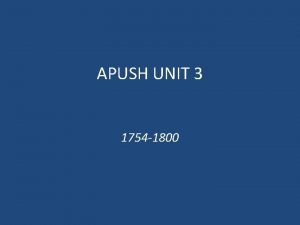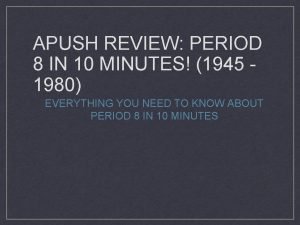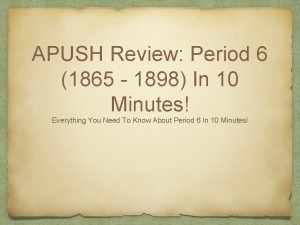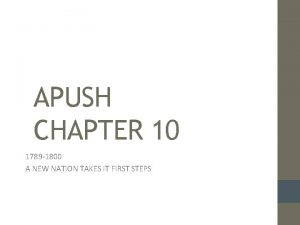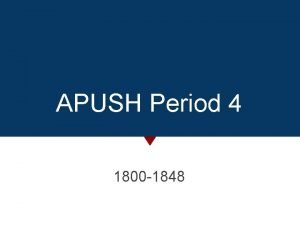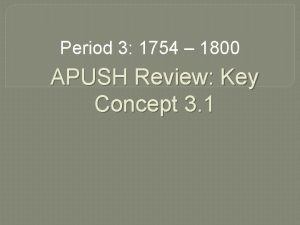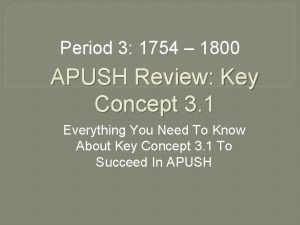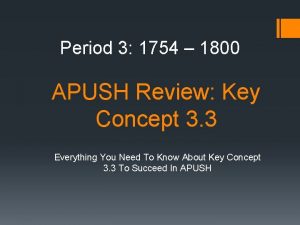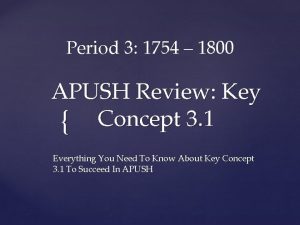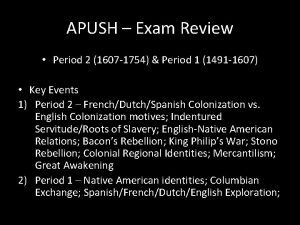APUSH Review Period 3 1754 1800 in 10








- Slides: 8

APUSH Review: Period 3 (1754 – 1800) in 10 Minutes Everything you need to know about Period 3 in ten minutes.

1754 - 1763 • French and Indian (7 Years War) was caused by English encroachment onto French lands ▫ Most natives (except Iroquois – split) sided with the French • Great Britain wins the war, France is removed from North America • Conflicts emerge between American colonists and Natives as colonists seek to expand ▫ Pontiac’s Rebellion -> ▫ Proclamation Line of 1763

1763 - 1776 • Britain is in debt from the war, ends salutary neglect, takes a more active role in colonial affairs ▫ Stamp Act, Townshend Acts, Intolerable Acts, etc. • Colonists resist this new control: ▫ Stamp Act Congress, Committees of Correspondence, First Continental Congress • Elites and everyday colonists were united against the British • Up until 1776, most colonists did NOT want independence, rather they longed for salutary neglect

1776 - 1783 • Common Sense: ▫ Thomas Paine, urged America to break away ▫ Helped influence the Declaration of Independence • Declaration of Independence: ▫ Grievances against KG 3, justification for breaking away ▫ Inspired by Common Sense and other Enlightenment ideas – natural rights, consent of the governed, etc. • Why did the colonists win the war? ▫ ▫ Familiarity with the land Military leadership (Washington) Strong beliefs (natural rights) Foreign Aid – France after Saratoga

1783 – 1800 • Fear of centralized power helped create the Articles of Confederation ▫ Weak central government, could not tax, no executive branch, most power left to states ▫ Trade issues emerged between states • Northwest Land Ordinance (1787): ▫ Provided a process for admitting new states ▫ Once a territory reached 60, 000 people, it could apply for statehood ▫ Banned slavery in NW Territory (MI, OH, IN, IL, WI) • Tensions emerged in different areas of the country (west v. east) ▫ Paxton Boys - PA ▫ Shays’ Rebellion - MA

1783 – 1800 (Cont. ) • Impact of the D. of I. and American Revolution? ▫ Revolutions in France, Haiti, and Latin America • Although some called for greater equality (Abigail Adams, PA Emancipation Law), framers of the Constitution postponed the issue of slavery • Constitution: ▫ Built on Compromises: Great, 3/5, Slave Trade ▫ Ratified after Federalists promised Antifederalists a Bill of Rights would be added

Beware of foreign alliances and government: political parties 1783 – 1800 (Cont. ) • Challenges to the new ▫ Navigation on the Mississippi River (Spain) �Pinckney’s Treaty ▫ Relations with Natives (not defined in the Constitution), land issues as Natives ceded more and more land • Washington’s Farewell Address: ▫ Warned of: entangled foreign alliances and political parties �Parties emerged anyway: Federalists (Hamilton) and Republicans (Jefferson) • Debates over power of government: ▫ State vs. National – VA and KY Resolutions. Can states nullify a federal law? (NO! Constitution is “Supreme Law of the Land”) ▫ Debate would continue until the Civil War

1783 – 1800 (Cont. ) • So Important it gets its own slide • Republican Motherhood: ▫ Women gained few, if any rights, after Rev. War ▫ Women were expected to instill Republican virtues (liberty, natural rights, etc. ) in children, and be active in their families ▫ Helped improve education for women
